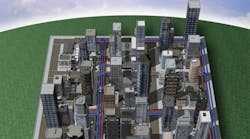Despite a long and impressive history—it originated with the ancient Romans and was advanced by Thomas Edison—district energy is underappreciated in the United States. It is growing—at present, there are approximately 2,500 systems operating in all 50 states—but not at the pace it is elsewhere. In the Middle East and across Europe and Scandinavia in particular, district energy is extremely popular. Why is it so much less so in the target-rich United States? This article offers an explanation and is intended to inspire discussion of and interest in district energy for the heating and cooling of buildings.
What Is District Energy?
By definition, if a single energy source serves more than one building, it is a district energy system. A district energy system has three major components:
• A thermal-energy-generating plant.
• A distribution system (piping).
• Building interconnections (e.g., meters, valves, pumps), often referred to as energy-transfer stations.
Thermal energy typically is in the form of steam, hot water, and chilled water delivered at temperatures and pressures suitable for use by interconnected buildings’ heating and cooling systems. This energy can be generated using boilers and chillers or with more sophisticated, efficient, and sustainable means, such as combined heat and power (CHP), biomass, heat pumps, solar thermal energy, and geothermal energy.
Figure 1 shows a typical urban district-cooling-and-heating installation. Chilled-water supply and return piping is in blue, while heating (steam and condensate or hot-water supply and return) piping is in red. Typically, these pipes are installed under streets or sidewalks.
Several district cooling systems serving urban environments (e.g., Atlantic City, N.J.; Chicago; Denver; Houston; Phoenix; Portland, Ore.; St. Paul, Minn.) were developed during the mid- to late 1990s, when chillers fairly commonly were located in high-rise penthouses and, consequently, were extremely expensive—and risky—to replace. Also giving rise to district cooling was the impending phaseout of chlorofluorocarbons per the Clean Air Act and The Montreal Protocol on Substances That Deplete the Ozone Layer, as many chillers were severely derated because of refrigerant retrofits and had to be replaced. Building owners and operators found connecting to a district chilled-water network an extremely attractive alternative because of its relative simplicity, capital-cost avoidance, and efficiency and capacity gains. In some cases, older buildings with older electric chiller plants were able to cut peak electrical demand by 50 percent or more and reclaim electrical-vault capacity for other uses.
Benefits of District Energy
Connecting to a district energy system yields quantitative and qualitative benefits related to:
• Building space. Space that otherwise would be dedicated to heating and cooling equipment in a connected building can be used to generate additional rental income. Additionally, aesthetics are improved, as unsightly air-cooled-condenser farms, cooling towers, boiler stacks, and the like are avoided.
• Operation and maintenance. District energy systems normally are staffed 24 hr a day by highly trained operators dedicated to equipment monitoring and maintenance. A typical building operations staff is somewhat less skilled and often preoccupied with tenant-related matters (e.g., responding to hot and cold calls).
• First and life-cycle costs. Compared with in-building heating and cooling plants, district energy solutions can save millions of dollars in up-front costs. What’s more, life-cycle costs are extremely competitive and often less with district energy than they would be with in-building heating and cooling. (For more, read Chapter 12, “District Heating and Cooling,” of 2012 ASHRAE Handbook—HVAC Systems and Equipment.)
• Energy and the environment. The site efficiency (usable energy out divided by energy in) of district energy incorporated with CHP is well over 75 percent. When fuel combustion and power transmission are taken into account, the overall efficiency of a typical electric utility power plant is less than 33 percent. But localized district energy does more than benefit a congested and inefficient electrical grid; it benefits the environment by emitting less pollution.
Despite its benefits, district energy does not make sense for every project; inadequate customer density or a lack of aggregated thermal loads may make it impractical. District energy is not a magic pill to solve our country’s energy needs, but another tool in our toolbox to promote energy efficiency, grid stability, and energy independence.
Where Does District Energy Stand in the United States?
The success of district energy in the United States has been said to be one of the country’s best-kept secrets. That is because most of the generation and distribution components of systems are hidden from public view; many people simply are not aware of the presence of district energy systems in their hometown or on their campus.
Typically, district energy systems are found where load densities are high, reliability is prized, and/or payback requirements are not as stringent as elsewhere. Not surprisingly, in the United States, district energy systems are found serving college and university campuses, major airports, large health-care and corporate campuses, manufacturing facilities, resorts, downtown business districts, government and municipal building complexes, military installations, and the like.
Why District Energy Is Not More Prevalent in the United States
Now, we get to the crux of the matter and again ask the question: With so much support and so many quantifiable benefits, why is district energy not being implemented everywhere in the United States?
First, despite life-cycle economics equivalent to those of self-generated heating and cooling plants, district energy systems have longer paybacks.
Second, most building owners do not know the actual costs of heating and cooling their buildings.
Third, despite a great deal of discussion in Congress, there is not a well-defined energy policy.
Longer paybacks. District energy systems are capital-intensive. Substantial investments are required in the initial stages of a project not only for energy-plant- and distribution-system construction, but business development, design, and contract negotiation. Most real-estate developers are looking for a quicker return on investment—frequently, two years or less—than a district energy system can provide. This is especially the case in commercial real estate, where more than five years of owning a facility is considered a very long time. Private industry tends to focus on short-term value generation and is not inclined to invest capital for long-duration assets.
Difficulty comparing values. There is a great lack of knowledge and understanding—and no shortage of misconceptions—regarding district energy. Unfortunately, discussions often are scuttled before they really get started. In this author’s experience, few building operators know the true cost of producing a unit of cooling or heating in their buildings because it is not easily discernible from the capital, maintenance, and operating expenses of their annual budgets. Often, the first question posed by a prospective end user is, “How much will it cost?” when the better question would be, “What is its value to me?” as value has quantitative and qualitative aspects.
It takes more than the cost of energy to pay for a ton-hour of cooling or a pound of steam, but many times, operators mistakenly equate only fuel or energy costs to costs of production. For example, say the peak efficiency of a chiller is 0.6 kw per ton, and the blended average electrical rate is 10 cents per kilowatt-hour. An operator may assume the cost to produce chilled water is the product of 0.6 times 0.1, or 6 cents per ton-hour. Unfortunately, it is not that simple. There are other considerations:
• The energy required for chilled-water and condenser-water pumps.
• Cooling-tower energy.
• Makeup-water and water-treatment costs.
• Operations-staff cost.
• Cooling-equipment cost.
• The cost and opportunity-cost value of the mechanical space.
• The cost of maintaining, cleaning, repairing, and replacing equipment throughout the life of the plant.
• Utility costs and salaries over the life of the equipment.
These are many of the true costs of ownership and energy generation included in a district-energy proposal. A district-energy proposal also will include:
• Plant production- and distribution-system construction.
• Project-financing availability.
• Discount rate.
• System reliability and availability.
• Makeup water.
• Water-treatment chemicals.
• Discharges.
• Refrigerant storage and management.
• Operations and maintenance labor (amount, expertise, training).
• Administration and management.
• Overtime premiums.
• Repair response time.
• Outside-contractor services.
• Spare parts and supplies.
• Electricity rates, natural-gas rates and supply, and peak power demand/ratchets.
• Increased on-site-plant electric service.
• Regulatory compliance and emissions reporting.
• Fees and licenses.
• Insurance.
• Design services (architecture and engineering).
• Architectural and environmental visual impacts.
• Replacement of old machinery and disposal of materials.
• Emergency/standby capacity and on-site fuel storage.
• Space for an on-site plant.
• Building security and safety.
• Productivity of building occupants.
Determining a cost or value for each of these will aid evaluations of district-energy service offerings.
Energy policy. Unlike the United States, many Scandinavian and Germanic countries have mature energy policies. For example, as a result of the oil crisis of the 1970s, Denmark enacted the Heat Supply Act, which essentially required all electricity-production facilities to recover useful heat for district-heating networks. Moreover, the policy dictated that buildings connect to a district energy system and that district energy be produced via the most efficient means possible: CHP. That regulatory requirement would not sit well in the United States, where reaction to the same crisis was not as focused and did not result in any long-term energy-policy solutions. Energy still is relatively inexpensive in the United States—fuel costs are at least half of what they are in other countries—so there is little incentive to invest in efficiency measures and conserve. This, it is hoped, is changing, as we have to be more accountable for the resources we consume. Right or wrong, the Danes developed a robust energy policy to ensure their energy independence. In the United States, a lack of a coherent energy policy is hindering efforts to achieve energy independence and accelerate the growth of district energy and CHP.
But the district-energy industry has not been idle and has received support from members of the U.S. government of late. Minnesota Congresswoman Betty McCollum sponsored a House briefing titled “District Energy: America’s Best-Kept Secret for Clean, Affordable, Homegrown Energy.” The Senate version of the briefing—“District Energy: How We Can Tap Renewable Thermal and Waste Heat”—was sponsored by Minnesota Sen. Al Franken. McCollum and Franken also co-sponsored the Thermal Renewable Energy and Efficiency Act of 2010, which would have stimulated the use of waste heat for building heating and cooling. Currently, national energy policy is largely stalled, but there has been progress to advance district energy and CHP:
• Tax-exempt financing for distribution systems.
• Investment and production tax credits.
• The Energy Independence and Security Act of 2007, which identified the need, but has not yet appropriated funds.
• An executive order recently issued by President Obama accelerating investment in industrial energy efficiency and calling for the addition of 40 GW of new CHP by 2020.
Furthermore, several states have funds available for studying and implementing CHP.1 This is good news for district energy, but loan guarantees or low-cost financing is what is needed most to overcome the hurdles of high initial capital cost and accelerate district-energy-industry development.
Conclusion
While the United States has many miles to go before it can emulate its Northern European colleagues’ policies, there has been limited but measurable progress by the government to create an energy policy and provide incentives for district-energy-system development. There just has to be greater awareness of the benefits and success of district energy on the part of the general public. With increased emphasis on environmental stewardship and energy resiliency, it is high time to bring “America’s best-kept secret” out into the open so more people can experience and enjoy its benefits.
Reference
1) Spurr, M. (2012, Third Quarter). Current incentives for CHP. District Energy, pp. 71-73.
SIDEBAR: District Energy During Hurricane Sandy
While Hurricane Sandy shut down several East Coast power plants, several district energy facilities remained operational. During the International District Energy Association’s (IDEA’s) Annual Campus Energy Conference and Distribution Workshop in San Diego in February, IDEA President and Chief Executive Officer Robert P. Thornton identified district energy facilities that experienced little, if any, service disruption while operating in “island mode” throughout the super storm, including those serving New York University, Co-Op City, and the Weill Cornell and Columbia centers of NewYork-Presbyterian Hospital in New York City; Stony Brook University in Stony Brook, N.Y.; Nassau Energy Corp. in Long Island, N.Y.; Princeton University in Princeton, N.J.; The College of New Jersey in Ewing, N.J.; Atlantic City Electric in Atlantic City, N.J.; and The Hartford Steam Co. in Hartford, Conn.
The performance of those facilities was not unexpected, as district energy systems have functioned similarly well during other natural disasters. This shows the viability of district energy systems, particularly those with combined heat and power as part of their dispatchable portfolio.
SIDEBAR: District-Energy Resources
In 2008, the International District Energy Association (IDEA) published “District Cooling Best Practice Guide.” Available for purchase ($395) at www.districtenergy.org/district-cooling-best-practice-guide, the hardcover reference book provides “practical insight and technical guidance on the ‘business’ of designing, owning, and operating district cooling systems.”
In 2012, IDEA published “Community Energy: Planning, Development and Delivery,” a free guidebook aiming “to support mayors, planners, community leaders, real-estate developers, and economic-development officials who are interested in planning more sustainable urban energy infrastructure, creating community energy master plans, and implementing district energy systems in cities, communities, and towns.” It is available for download at http://bit.ly/Community_Energy.
The U.S. Green Building Council’s LEED rating program has begun to recognize the influence of district-energy and combined-heat-and-power systems on building efficiency. To learn more, read the September 2011 HPAC Engineering article “LEED Opportunities With District Energy” by J. Tim Griffin, PE, CEM, LEED AP (http://bit.ly/Griffin_0911).
SIDEBAR: Where is District Energy Growing in U.S.?
In the United States, master-plan studies incorporating district energy and energy independence have been conducted for several areas, including the State of New York; Washington, D.C.; and Loudon County, Va. Additionally, a district heating system serving state and city government buildings and portions of the downtown is being developed in Montpelier, Vt.
Below is a map of district energy systems in the United States.
The vice president of energy services for Syska Hennessy Group, Steve Tredinnick, PE, CEM, has more than 30 years of HVAC-related experience, the last 19 focused on district energy systems. He is the chair of the chilled-water-plant subcommittee of ASHRAE Technical Committee (TC) 6.1, Hydronic & Steam Heating Equipment & Systems; a past chair and the current Handbook chair of ASHRAE TC 6.2, District Energy; and a past member of the board of the International District Energy Association. He has a degree in architectural engineering from The Pennsylvania State University.
Did you find this article useful? Send comments and suggestions to Executive Editor Scott Arnold at [email protected].











